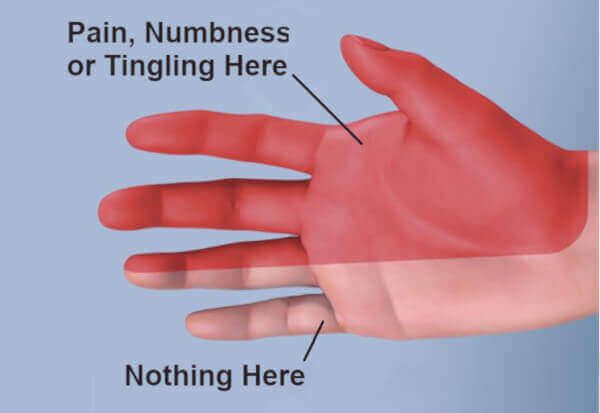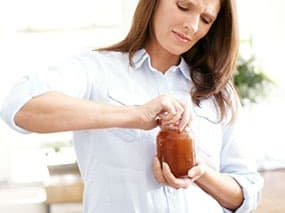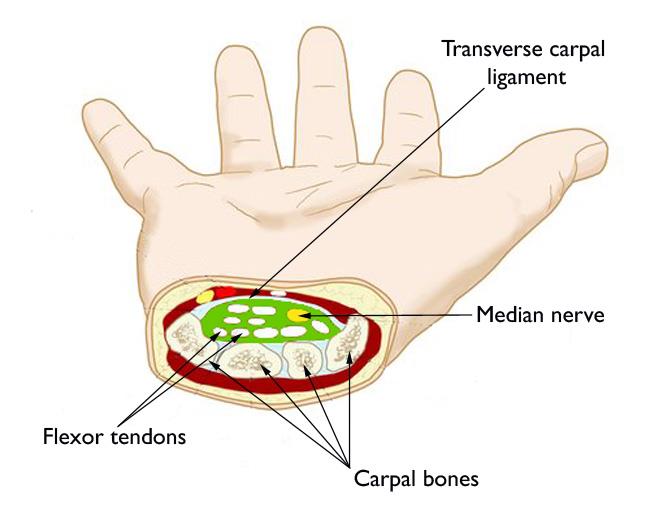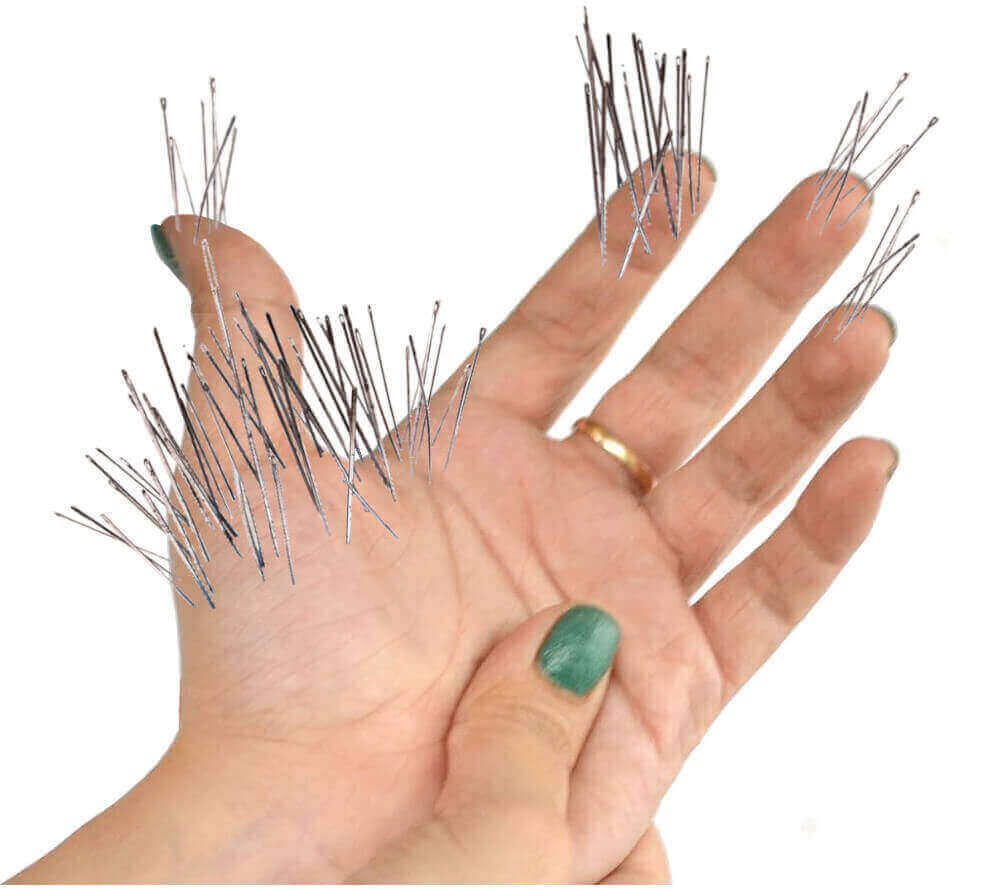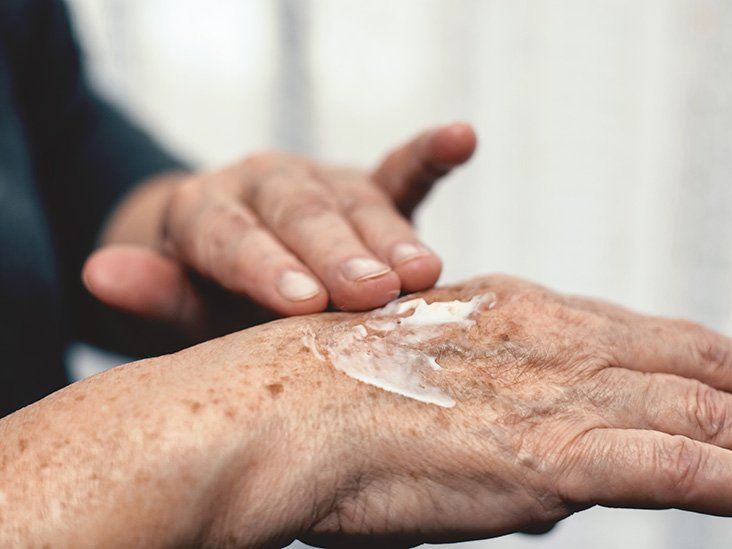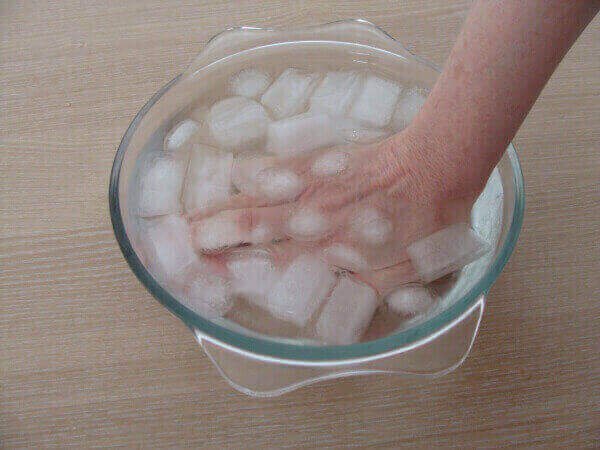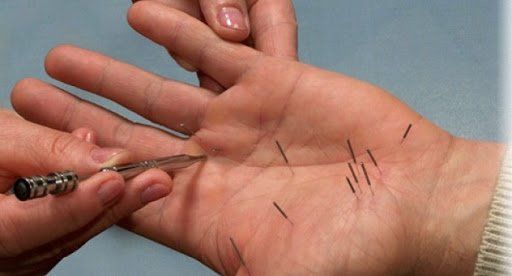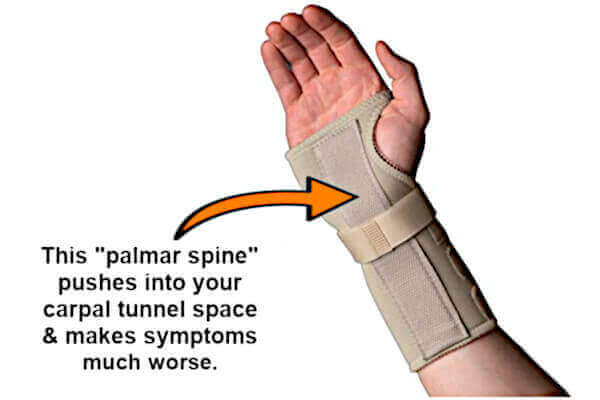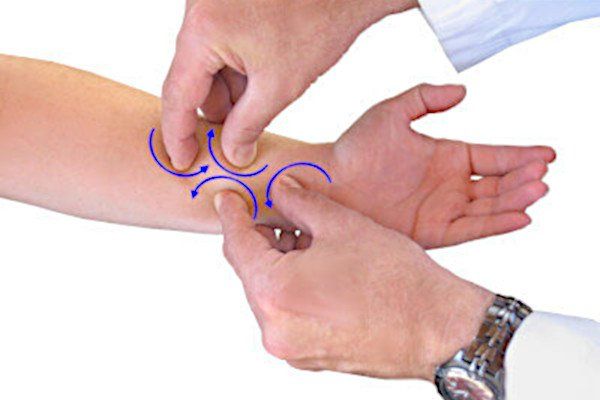Where Carpal Tunnel Pain is Felt
From Dr. Z - Carpal tunnel syndrome specialist
Where Carpal Tunnel Pain is Felt
Exactly where carpal tunnel pain is felt is different for everybody. But the majority of sufferers feel pain in the first three fingers and/or the palm. There can be many qualities to the pain, like sharp or dull versus intermittent or persistent.
But pain is only one of several symptoms of carpal tunnel syndrome. The others are usually numbness and tingling (or "pins and needles") in the same areas.
This article describes more about the pain, numbness and tingling of carpal tunnel syndrome. It also includes other symptoms to look for.
Where carpal tunnel pain is most intense
For most people who suffer with this condition, the location where carpal tunnel pain is most intense is the palm of the hand and the first three fingers. The image above illustrates this pattern.
Note that the little finger (pinky finger) is never involved. Nor is the pinky-side of fourth finger.
The location where carpal tunnel pain is usually most intense is the
thumb
and
forefinger
(pointer finger). Most times, the base of the thumb also hurts more than the rest of the palm.
As carpal tunnel syndrome starts out, there are 2 key symptoms to look for. In fact, these symptoms distinguish carpal tunnel syndrome from other disorders like wrist tendonitis. The early carpal tunnel symptoms to look for are:
- Pain (or numbness or tingling) never occurs during the day, as you're using your hand. Instead, symptoms appear only when your hand is resting. In contrast, tendonitis for example, only hurts when your hand is working.
- In the beginning stages, carpal tunnel symptoms usually appear only at night. When you're trying to sleep, you might be awakened with the need to rub out the pain or shake out the numbness.
Other carpal tunnel symptoms
Pain, numbness, and tingling are the key signs you're getting carpal tunnel syndrome. But other symptoms are also often felt. They're most common in the same location (first 3 fingers and palm) and include:
- itching
- burning
- loss of finger dexterity
- electric shock sensations when grasping (e.g., a cup or phone)
- hand or finger weakness
- feelings of finger puffiness (without signs of swelling)
As carpal tunnel symptoms get more severe
Carpal tunnel syndrome is a progressive disorder. That mans under ordinary conditions and without treatment, it worsens over time. As it goes from the mild and moderate stages, it enters the severe stage.
This is when symptoms worsen in intensity. If you had only one symptom (like pain) then others will probably begin to show. Also, symptoms become present during the day, whether or not you're using your hand. Basically, there's no rest from severe carpal tunnel syndrome.
Also in the severe stage, new problems begin to happen. Patients in the severe stage tend to lose significant hand strength. It's especially noticeable with grasping. Dropping objects like a coffee cup or phone is common.
More advanced symptoms also include loss of temperature sensitivity in the fingertips. As a result, it's not unusual for patient to burn themselves around the kitchen stove.
Knowing the location where carpal tunnel pain is most intense is just as important as understanding the quality of the pain. It can range from merely distracting or absolute punishing.
Of the different qualities of pain, each one can persist or be intermittent. Also, some sufferers experience just one of these pain qualities. Others may feel more than one type. Those other qualities of carpal tunnel pain are described as:
- dull
- deep
- hot/burning
- throbbing
- pounding
- sharp
- shooting
- grinding
- aching
- gnawing
What causes these painful symptoms?
Carpal tunnel syndrome is a neurological disorder affecting more than five million Americans. It happens because we stress our flexor tendons (those responsible for grasping) which are located in the forearm.
It's especially common when we stress the tendons repetitively. In fact, it produces a type of tissue damage called repetitive stress injury. This is when the stress produces tendon inflammation and swelling.
When the tendon inflammation and swelling happens anywhere else in the body, it's called tendonitis (or tendinitis). But when the swelling happens deep inside the wrist joint, the result is carpal tunnel syndrome.
The reason that swelling in the wrist causes carpal tunnel syndrome is because the tendons are crowded into a tight space. It's called the carpal tunnel passageway. Inside this space, the tendons are packed tightly against the median nerve.
The median nerve is a major nerve of the hand. And it doesn't like being cramped. So when the nearby tendons swell, they push on the median nerve, cramping it even more. Eventually, and with more swelling, the tendons squeeze and crush the nerve.
This crushing on the median nerve produces all of the pain and other symptoms of carpal tunnel syndrome.
Treating carpal tunnel syndrome
Chances are you're less concerned with where carpal tunnel pain is located than how to treat it. But don't worry, you can treat it effectively - with or without surgery.
The general rule in carpal tunnel therapy is that the more advanced your symptoms, the less likelihood your hand will be restored to normal. That goes for nonsurgical and surgical interventions.
Treating carpal tunnel pain and other symptoms should begin with nonsurgical remedies first. In fact, the American Academy of Orthopedic Surgeons (who regulate hand surgery) recommend trying ALL nonsurgical therapies before considering hand surgery.
The 10 approved nonsurgical remedies are listed below.
10 carpal tunnel pain treatments
It doesn't matter where carpal tunnel pain shows up: it hurts and you need to get rid of it. In fact, there are many ways which, over the years, have proven to be very effective. Some are better than others.
The list below represents the 10 most commonly used nonsurgical treatments to eliminate carpal tunnel pain. They are listed by what the majority of doctors consider best - from least effective to most effective.
Pain medicines
Drugs are not an effective method to relieve carpal tunnel pain. But pain medicines (pain pills) are by far the most often-used methods to attack carpal tunnel pain. Technically called analgesics, they relieve pain by reducing inflammation.
That's why non-steroidal anti-inflammatory drugs (NSAIDs) are in high demand. The most common ones are over-the-counter products like Motrin, Advil, Motrin, Aleve, Tylenol, Naproxen and Aspirin.
These medicines offer some pain relief. The problem is that the relief is temporary. Within a few hours, the carpal tunnel pain returns.
But there's a bigger downside to these drugs. You cannot take any of them on a chronic (long-term) basis. That's because the FDA says they're harmful. Long term use can lead to heart attack, stroke, and kidney or liver damage.
Ointments
Topical ointments (e.g., Biofreeze, Penetrex, Topricin) are popular pain relievers. Patients claim they help in spots where carpal tunnel pain is most intense. But like pain medicines, the relief is only temporary.
Moreover, the relief is merely a placebo. That means it works only because you believe it works due to the soothing skin effect. In reality, the penetrating ingredients only pass through your skin for a distance of the thickness of regular paper. But the area of injury is inside your carpal tunnel space, deep inside your wrist joint.
Ice baths or heat
The effectiveness of either ice baths or a heating pad for carpal tunnel relief is constantly debated. Sufferers swear by one or the other. Still other patients swear that ice, quickly followed by warm water, works best. This is called a contrast bath.
In reality, both ice and heat do provide some relief. But both are only temporary. Their effect diminish when you remove your hand from the treatment.
Cold temperatures reduce swelling and inflammation. But heat increases blood flow and restores damage to tissues. So you would need to use ice and heat almost continuously - for weeks - to achieve good results.
Ultrasound therapy
No matter where carpal tunnel pain is bothersome, ultrasound therapy is relatively effective. The effectiveness comes about because ultrasound heats tissue. So in effect, it has the same beneficial effect as using a heating pad.
Warming any damaged tissue accelerates the healing process. But as soon as the ultrasound (or heat) is discontinued, the beneficial effects on carpal tunnel syndrome also diminish.
Yoga exercises
After years of clinical data, it's certain that yoga can improve carpal tunnel symptoms. Many of the stretching exercises target the upper body and wrist area - at the center of problem which causes this disorder.
The wonderful upside of yoga is that it can relieve symptoms permanently. But permanent relief only happens when yoga is practiced on a regular basis.
Acupuncture
Clinical studies on acupuncture have shown it has beneficial effects on carpal tunnel syndrome. It's most effective particularly where carpal tunnel pain is the predominant symptom.
The mechanism by which acupuncture works is not currently understood. However, we know its effects are usually temporary. When the needles are removed, the pain relief can last up to three days until it returns.
Resting your hand
The body's natural response to injury is rest. It's why we feel tired after a severe injury, which is the body's way to shut down and repair.
And when this simple concept is applied to healing carpal tunnel syndrome, the effects can be dramatic. Just avoiding the activity which caused the hand stress will allow your body to naturally repair the damaged tendons.
But you should know that simple rest will not be effective if symptoms are severe or if the carpal tunnel syndrome is advanced. At that point, additional therapy is required. That means, night bracing, stretching exercises, and myofascial release massage - described below.
Night bracing
It might sound too good to be true, but bracing your hand at night while you sleep is one of the most effective carpal tunnel therapies. This simple technique is amazingly effective and simple to use.
When we sleep, we unconsciously bend our hands backward. This is harmful to the carpal tunnel, and adds pressure to the median nerve. But a carpal tunnel night brace keeps the hand in the neutral position, preventing the harmful bending.
But not just any brace will help. You must use a certified carpal tunnel night brace. Other braces typically sold in Walmart, CVS, Walgreens, etc. might claim they're "for carpal tunnel syndrome", but they're not.
The way you can tell it the brace is not made for carpal tunnel syndrome is if it has a metal palmar spine. That means it's not to be used for carpal tunnel syndrome. That spine will actually make your symptoms worse, and you'll wake up with more intense symptoms.
Stretching exercises
Stretching exercises specifically designed to relieve carpal tunnel syndrome help eliminate symptoms permanently. The exercises loosen tendons, making them easier to glide smoothly and operate efficiently.
The exercises also break up adhesions that restrict tendon movement. Carpal tunnel stretching exercises are perhaps the lease expensive, yet most powerful powerful carpal tunnel fighters you can use. And when used in combination with night bracing and myofascial release massage (below), even severe symptoms can be eliminated.
Myofascial release massage
Almost everybody knows that message is good for just about any ailment. But for carpal tunnel syndrome, a specific kind of massage is most effective.
It's called myofascial release massage. This is the "go-to" remedy used by therapists every day. The reason is because it breaks apart adhesions which restrict tendon gliding. It's a similar process which occurs during carpal tunnel stretching exercises.
But myofascial release is a much more aggressive therapy. Usually it's reserved for more advanced or severe symptoms. It requires daily application for at least 30 days to be effective.
Another benefit of myofascial release massage is that it promotes blood circulation in the wrist joint. This helps the healing process. It also simultaneously drains excess fluid from the wrist joint. This reduces pressure on the median nerve.
Thus, myofascial release massage eliminates adhesions and restrictions, promotes blood flow, and drains excess fluid. All of this reduces tendon inflammation and subsequent pressure on the median nerve. The result is that carpal tunnel symptoms dissolve permanently.
Conclusions
The location where carpal tunnel pain is most intense differs among patients. It could occur in the fingers, palm, or even radiate up the arm. The pain can also span the entire spectrum of pain qualities, from a dull ache to a deep pounding. In some patients the pain is temporary. But in others it's unrelenting. However, one thing is certain: the more your carpal tunnel syndrome advances the more intense the pain becomes. And it's also more challenging to treat.


